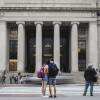Updated at 11:09 a.m. June 15
The U.S. Supreme Court is poised to issue a historic ruling this month affecting how colleges consider race in admissions. Here's what you need to know about the decades-long debate over affirmative action and the potential effects of the court's decision.
What’s at stake?
The case could upend 40 years of legal precedent and fundamentally alter the landscape of higher education by making race considerations in college admissions illegal.
Decades ago, colleges began considering race as one factor among many in the admissions process as a way to help remediate past discrimination, including the effects of slavery.
If the Supreme Court ends affirmative action and colleges curtail the consideration of race as a factor in admission, campuses could become far less racially diverse.
More Education
How did we get here?
In the landmark 1978 case Regents of the University of California v. Bakke, the Supreme Court ruled that racial quotas in admissions were unconstitutional. That decision came after Allan Bakke, a white student, was twice rejected from UC Davis’ medical program, leading him to challenge the constitutionality of its affirmative action program.
In his majority decision supporting UC Davis, Supreme Court Justice Lewis Powell, a Virginian nominated by President Richard Nixon, held out Harvard’s admissions program was an example of how race can properly be taken into account in college admissions.
"Race is considered in a flexible program designed to achieve diversity, but it is only one factor weighed competitively against a number of other factors deemed relevant,” Powell wrote. “Under such a system, each applicant is treated as an individual regardless of race and is considered in competition for each seat in the class."
The latest debate
Nine years ago, a group called Students for Fair Admissions sued Harvard University. Led by Edward Blum, a conservative legal strategist and longtime critic of race-based admissions, the group claimed Harvard held Asian-American applicants to higher academic and personal standards in the admissions process.
Harvard denied those charges, arguing that race is just one factor in its admissions criteria. Harvard also noted that its population of Asian-American students doubled from 15 to 30 percent in the last 20 years. No Asian American applicants took the stand to testify that they were denied admission to Harvard because of their race. The plaintiffs relied on statistical analysis and administrative notes in the margins that they claimed exhibited implicit bias.
The decision, followed by an appeal
In 2019, a federal judge in Boston ruled that Harvard does not discriminate against Asian American applicants.
Students For Fair Admissions disagreed. The group appealed the judge’s ruling and filed another lawsuit against the University of North Carolina. Those complaints have reached the Supreme Court.
Last October, Supreme Court Justice Clarence Thomas and members of the majority conservative court asked questions from the bench that were deeply skeptical of the educational value of racial diversity.
Many experts now predict the court will strike down race-conscious admissions.
Supreme Court Justice Clarence Thomas, Holy Cross
Thomas is expected to issue the majority opinion on the case, which ironically benefitted students like him in the 1960s. He attended the College of the Holy Cross in Worcester through a program designed to make the campus more racially diverse.
In his 2008 memoir, "My Grandfather's Son," Thomas said he felt stigmatized by affirmative action because his classmates at Holy Cross and later at Yale Law School viewed him as a beneficiary of the program and not as an accomplished student.
The effects of a ban
Nine states already have bans against race-conscious college admissions: Arizona, California, Florida, Idaho, Michigan, Nebraska, New Hampshire, Oklahoma and Washington. States that have banned affirmative action have seen a growing gap between the percentage of Black, Hispanic and Native American high school graduates compared to the percentage of those students enrolled in large public universities.
After California voters enacted a statewide ban in 1996, Black enrollment at the University of California's most selective schoolsdropped dramatically. At U.C.L.A., the percentage of Black students fell by more than half, from 7% to about 4% within two years.
What's next?
Colleges have said they will continue their efforts to admit a racially diverse student body and even boost their recruitment efforts.
Some civil rights activists have said that’s not enough, and have proposed adoptingslave descent as a factor in admissions.
Such an approach is akin to “legacy admissions,” under which the children of alumni get prioritized in admissions, advocates have said.
“Affirmative action, when it started, was aimed at addressing and remedying the history of discrimination against Black Americans and trying to open up opportunities for them,” said Ted Shaw, director of the Center for Civil Rights at the University of North Carolina. “It would be correct to return to the roots of these efforts."
Critics have questioned that approach, saying it would leave out other marginalized racial and ethnic groups, including Latinos, Asian Americans and Native Americans who could be affected by a potential ban.
Correction: An earlier version of this story misstated which states have bans on affirmative action in college admissions.









